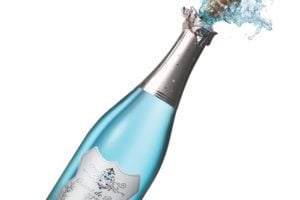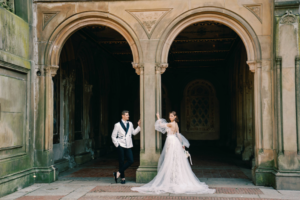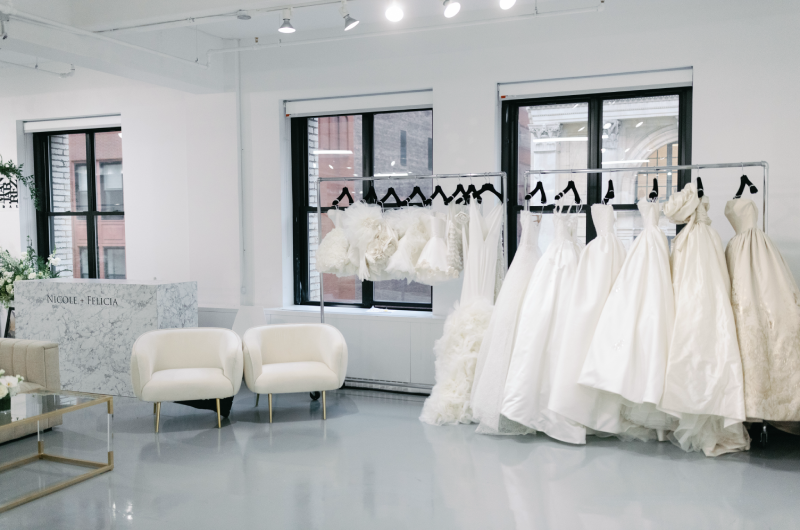
by Stevie Paige
For Christina Wettstein, her calling to commerce couture was connate. Throughout Christina’s teenage years, her mother managed a clothing store, and it was there, among the rows of coat racks draped with pristine fabrics, where Christina discovered her passion for fashion—specifically, buying and managing sales for luxury clothing brands. Fashion styles range from streetwear to chic to business casual. With so many avenues, finalizing a career plan in fashion can be overwhelming. Yet, full clarity of her calling was achieved upon seeing a couture gown at her first-ever attended bridal market.
“It was always a dream to go to bridal markets. The first market I got to attend, I was 19, and I thought I had just died and gone to heaven.”
Following college, Christina managed a luxury bridal store in Minneapolis, specializing in couture designer bridal gowns. Following a string of sales management jobs with several luxury bridal brands based in Los Angeles, Christina decided to create her own destiny and co-found the bridal sales agency Coterie White in late 2018. She currently works as the director of brand strategies.
Then, less than six months later, the COVID-19 pandemic took over the world. Bridal shops were closing their doors, travel was limited, and suddenly, there was a need to bring dresses to people. At the time, the concept was very new, and only a handful of designers in the United States were hosting and/or participating in pop-up bridal markets. Seeing the demand for a destination where designers could display their creations in large numbers to combat low visibility/exposure and limited accessibility to in-person stores caused by the pandemic, Christina, along with Kimberly Marcoux, co-founded Melange de Blanc, a pop-up bridal market and a premier wedding destination for bridal fashion. Melange de Blanc has two prime locations in New York City, NY, and Palm Beach, FL, where they host seasonal trade shows at set venues. While Melange de Blanc has evolved more into a tradeshow operation, they periodically return to their pop-up market roots to test out new markets in metropolitan cities throughout the U.S.
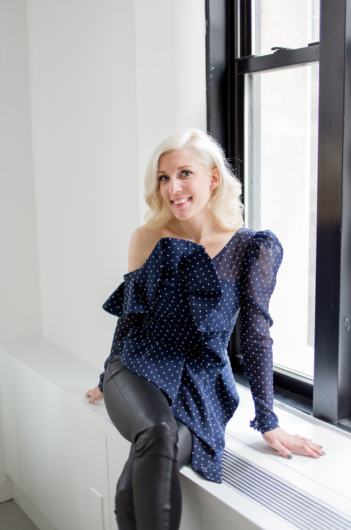
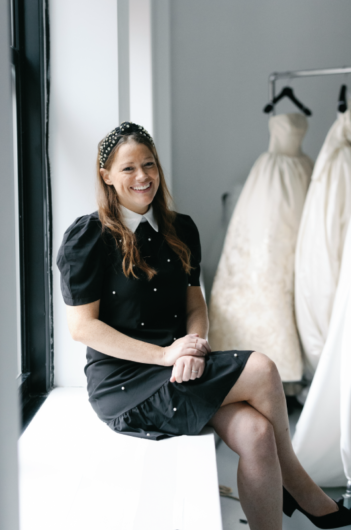
Kimberly and Christina thrive as a team. Both have worked in bridal fashion for over ten years. Much like the pieces a bride wears on her wedding day, “something old and something new” are pivotal to the success of a business. Both women are highly skilled at managing and masterminding strategic growth, budgeting, planning, and logistics, which require devising methods that are ever-changing and evolving with trends. Both women also have a built-in rapport and working relationship with brands from years of experience in the industry, earning themselves a trusted reputation that aids them when recruiting other brands. This upcoming market in October will be Melange de Blanc’s twelfth market since its founding.
“Our failure is actually our greatest success. It’s just a matter of rolling with the punches, learning, growing, trying new things, and being open.”
Melange de Blanc’s tagline is “Bridal Market Reimagined,” which Christina defines as “coming at business from the customer’s point of view and creating opportunities for buyers to get to know designers.” Rather than being “so business-y and tradeshow-y,” Melange De Blanc reimagined the stuffy showroom stereotype by inventing friendly, fun, and comfortable networking events like Tacos & Tequila to create a more relaxed yet professional way for customers and designers to interact. Melange de Blanc also prides itself on offering a wide selection of designs and designers at tradeshows and pop-up markets to accommodate all types of buyers. Designers are intentionally brought in to encourage diversity by offering different styles and price points.
Generally, the United States has a higher price point or “an appetite for a higher budget” when compared to other countries like Asia or the UK. Therefore, when throwing a pop-up market in the United States, Melange is able and financially justified to bring in over-the-top international designers, like Sara Murad, who charge up to $20,000 per dress.
While a market in April features 25 to 30 designers, the market in October will feature up to 60 designers. This is due to the intense competition of the bridal market in April. April is international bridal market season, and following the natural course of market timing, designers will first attempt to sell in markets like Japan, London, Milan, and Barcelona, before the U.S. metropolitan cities like New York and Chicago.
When initially starting Melange de Blanc, one of the first steps for Kimberly and Christina was researching potential venues. The hunt was on for an attractive and accommodating venue. Christina revealed she enjoyed researching up-and-coming boutique hotels to potentially host a Palm Beach market. Boutique hotels are defined as a “a type of hotel that feels small, intimate, and quaint; stays true to the local culture; has less than 100 rooms and offers guests an ultra-personal service.” Finally, her persistence paid off in the shape of a colossal, candy-colored coastal palace. The Colony, which has become one of the most sought after wedding venues in Florida, was available for rent. Melange hosted several events at the Colony before the company expanded to host their first trade show, in Palm Springs.Following the success of the Palm Springs tradeshow, Melange felt motivated to expand again. For their New York trade show, they secured a venue right in the hustle and bustle of Manhattan.
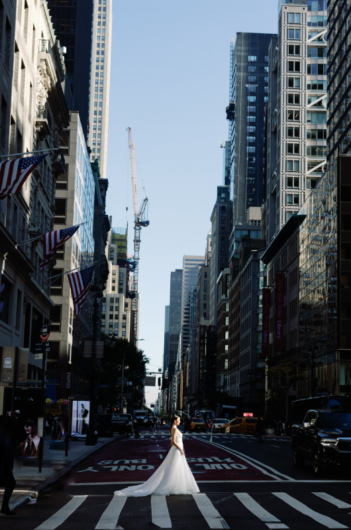
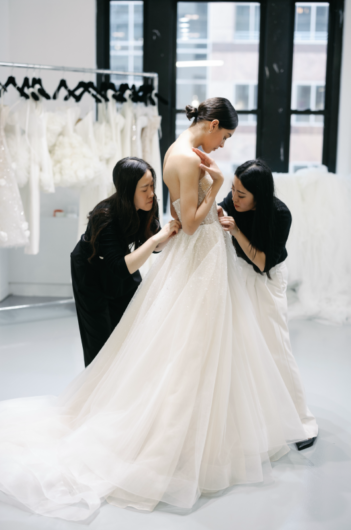
Christina, with the assistance of Erica, Melange de Blanc’s brand curator, books the brands to fill the trade room space, which ranges from 20,000 to 50,000 square feet. They then create the floorplan from scratch, which includes measuring and ordering the walls for the space, ordering lights for the space, managing the electricity in the space, adding the logos, and renting and bringing in furniture and decor on loading trucks. The space for the New York trade show is right in the heart of the city on Fifth Avenue, between 37th and 38th Street. Every hour is meticulously planned out for set-up day, which roughly takes around 16 hours. A total of 20,000 dresses come to the market on trucks. Designers are then given the autonomy and creative control to come in and set up their space. Each designer builds a showroom that ranges from 100 to 1,000 square feet, complete with statuesque models showcasing their elegant designs. When preparing for the trade show in Florida, Malande de Blanc brings their own garment racks, tables, and chairs from their commercial storage unit.
“We’re partners with a lot of trade shows where they have some huge contracting team behind them. It’s just us. And we love that.”
One design team that Melange de Blanc frequently features at their pop-ups is Nicole + Felicia, a “young, cool, fresh” design team in Taiwan whose recent projects include dressing J-LO for the Grammys and designing four dresses for Taylor Swift’s Eras Tour.

“They started buying and acquiring from Melange, and now I would say I’m dear friends with the team. I just adore them. Nicole + Felicia comes to everything we do, even our pop-up in Milan.”
Other brands working directly with Melange de Blanc include Ines Di Santo, Hera Couture, Trish Peng, Daalarna, Mariana Hardwick, Watters Designs, and La Premiere. These brands and more will be featured in the New York market in October.
This season, Melange has 25 countries represented in their New York showroom. In addition, this past year, Coterie White, Melange De Blanc’s sister company, expanded into Europe, birthing Coterie White Europe. Rather than strictly prioritizing American designers, the team has expanded its audience market to include international designers and appeal to as many customers as possible.
In international trends, Christina points to an “ode to a more traditional bride,” especially with Italian designers. However, designers worldwide appear to be prioritizing not only the quality of the fabrics, but also the timeless style and aesthetic. This timeless, traditional aesthetic includes gloves, 20-inch veils, and a transition from natural waist ball gowns, which were fashionable for a long time, to drop-waist or bask waists. Trumpet gowns and satin are also making a return. Heavier, more ornate details and beading are also big again.
“A few years ago, it was unheard of to have a 120-inch veil, and now we’re selling a ton of 200-inch veils. It’s bigger, better, grander right now in bridal.”
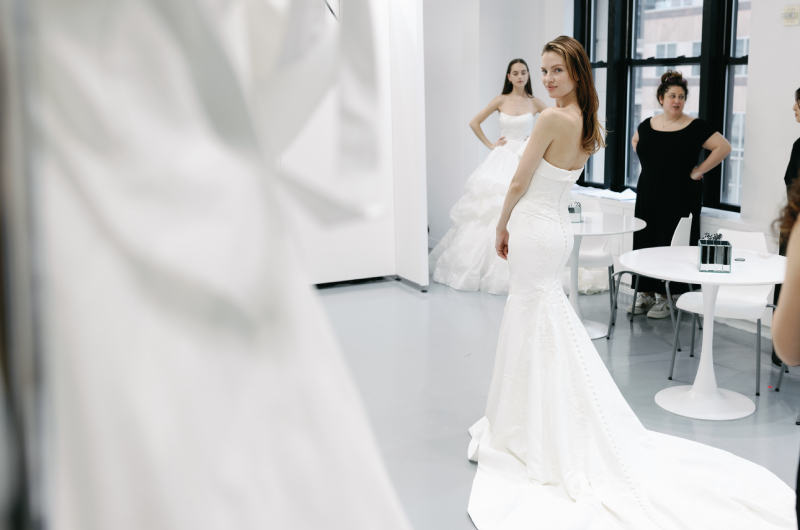
Internationally, Christina says bridal fashion is largely taking from Australian influence, permeating across country lines, influencing international designers from Germany, the UK, and the United States. Whereas seven years ago, bridal fashion heavily conveyed Israeli influence, which largely featured lace and beads and leaned into vintage. This “cool girl” Australian look includes off-the-shoulder styles, nautical nods, and light-weight, breezy fabrics like chiffon, satin, and lace. This look is trendy and sexy, yet not super sheer.”
In Melange de Blanc’s future, most notably, the team will join Sì Sposaitalia, the bridal market in Milan, Italy, in October to participate in Milano Bridal Fashion Week for their third collaboration. Christina emphasized what a treat it was to test out Melange De Blanc brands in Milan. However, Christina did point out Italian buyers’ extremely high expectations and unabashed impulse to say “no” compared to more easily enticed American customers. However, she insists their high expectations are warranted, as Italian bridal designs are unmatched in terms of fabric quality.
“The Italians can do beautiful craftsmanship like no one else can. They have quality like no one else. For us to be able to have a few Italian brands joining us is so, so exciting.”
“We can’t be that reactive to the trends that show up in Bridal Week. Something that happens a year before, we can start to influence and see trickle into bridal. Bridal is just a bit more evergreen than fashion is for Fashion Week. The trendier pieces that show aren’t going to be the bestsellers for another year or two. Fashion moves so quickly.”
Through her work building and managing Melange de Blanc, Christina has traveled the world, met with premier bridal designers, and sat courtside at Fashion Week in Milan and New York. In many ways, her job oscillates as both a dream and a reality. However, the most gratifying moment is seeing a designer not yet discovered find their wings. Christina reflects on when Kleinfeld, who they’d worked with in the past, expressed an ardent desire to carry Nicole + Felicia’s, a then virtually unknown design team, designs in their stores. That was their first experience selling in America.
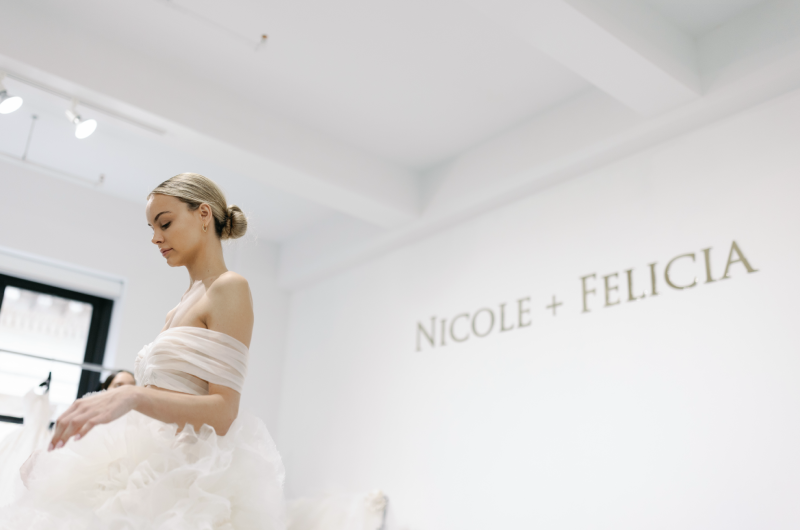
“To see someone’s hard work come to fruition is amazing. Fast forward, we had our fourth season with them [Nicole + Felicia] last season, and to see the frenzy behind this brand and the amount of stores that are fighting over them .They worked so hard. They listened. They tried. They did all the things they were supposed to do, and then to see them achieve success is really cool. We’re just a small part of it, but to be able to see someone else’s experience is amazing.”



